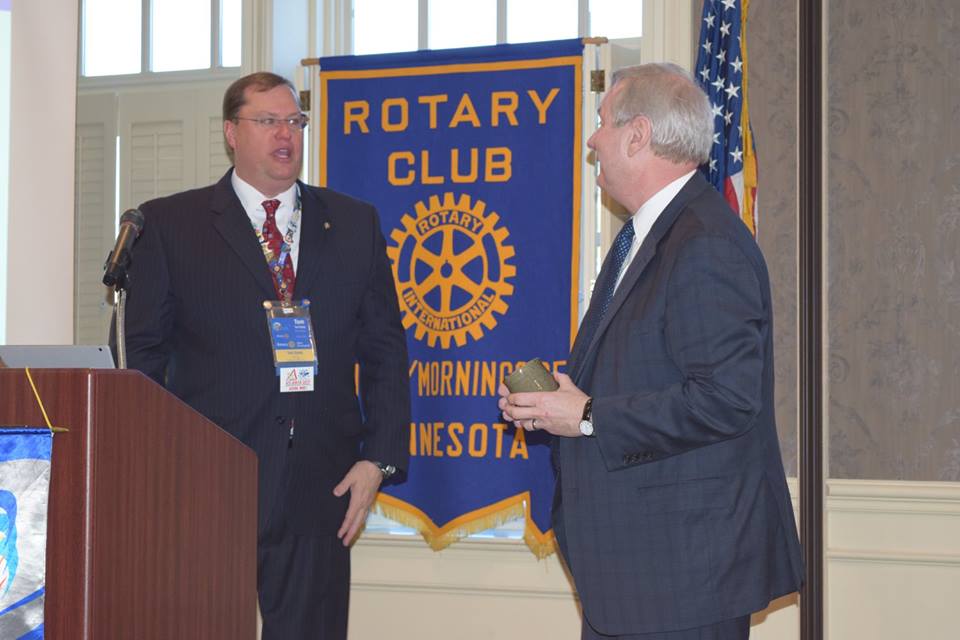In review...March 7 meeting
Posted by Mark Jessen on Mar 07, 2017

Rotary Club of Edina members attended the annual joint meeting with the Edina Morningside Rotary Club Tuesday morning, March 7. EMRC hosted our club at the meeting at the Edina Country Club, and welcomed members with balloons, welcome signs and flowers on the tables. The program speaker at the meeting was Dr. Michael Osterholm, former head epidemiologist for the Minnesota Department of Health.
Click on the link for more on the joint meeting...
.jpg)
The joint Rotary meeting with the Edina Morningside Rotary Club hosting the Edina Noon Rotary Club at the Edina Country Club was called to order by EMRC President Tom Gump and our President Ann Platt at 7:30 a.m. Working the desk for the our club were Steve Slyce and Greg Yoch. Tom Gump pointed out the social events that the two clubs host together and the projects both work on including VEAP, Veterans Day, Vocational Ethics Day, bell ringing for the Salvation Army, the Guatemala water project, Camp Enterprise and Youth Exchange.
 EMRC inducted two new members: June Schmidt and Eric Gustafson. The guests for the Rotary Club of Edina included Solvei Wilmert, Lee Renneke and Jeff Braun, all hosted by Scott Neal. Tom Gump also recognized the attendance of past District Governors Sandy Schley and Tim Murphy and then someone named Jeff Ohe.
EMRC inducted two new members: June Schmidt and Eric Gustafson. The guests for the Rotary Club of Edina included Solvei Wilmert, Lee Renneke and Jeff Braun, all hosted by Scott Neal. Tom Gump also recognized the attendance of past District Governors Sandy Schley and Tim Murphy and then someone named Jeff Ohe.Peter Kelley from EMRC made an announcement that there are nine host families needed for the upcoming year of Youth Exchange. Anyone interested please contact Peter Kelley.
EMRC member John Pastor introduced the speaker: Dr. Michael Osterholm, former head epidemiologist for the Minnesota Department of Health and author of the book: “Deadliest Enemy: The War Against The World’s Deadliest Germs." Dr. Osterholm is an expert in the field of infectious diseases and shared his concerns for our children and grandchildren in the years to come and perhaps right around the corner. With the population explosion on earth and the instability of nations around the globe, the conditions are ripe for another epidemic or pandemic to break out again much like the Ebola outbreak in West Africa last year. The World Health Organization, which is critical in dealing with such epidemics, has not had its funding increased in over 30 years and the next epidemic/pandemic is just around the corner. In fact, Dr. Osterholm believes that an influenza pandemic is inevitable.
 Africa is the fastest growing continent and the conditions for another Ebola outbreak are ideal due to the growing slums. Kinshasa is a slum composed of 7 million people and is the perfect storm for the creation of viruses. The Aetes Aegypti mosquito, which had nearly been eliminated from South America and is the carrier of yellow fever and the Zika virus, has come back with a vengeance. Due to Venezuela’s economic destruction and the rise of illegal gold mines as one of the few industries employing people, has helped cause the urbanization of malaria.
Africa is the fastest growing continent and the conditions for another Ebola outbreak are ideal due to the growing slums. Kinshasa is a slum composed of 7 million people and is the perfect storm for the creation of viruses. The Aetes Aegypti mosquito, which had nearly been eliminated from South America and is the carrier of yellow fever and the Zika virus, has come back with a vengeance. Due to Venezuela’s economic destruction and the rise of illegal gold mines as one of the few industries employing people, has helped cause the urbanization of malaria.The frequency of travel by 1.4 million people across national boundaries last year and the deployment of 62,000 vessels transporting goods around the globe at any given time has systemized the spread of infectious diseases. Of the 30 essential drugs in the world, none are produced in the United States. Here is a list of the Global Crisis Agenda for Infectious Diseases:
- Influenza
- Antimicrobial resistance
- Vaccines and diseases of critical regional importance
- Mosquitos, mosquitos, mosquitos
- Bioterrorism
- Gain of function and dual use research of concern
- HIV, TB and Malaria
- Climate change
- All about the animals
Unfortunately, public health has become a partisan issue so the likelihood of reasonable cooperation to combat infectious diseases has become more remote. A conversation around what legacy we want to leave our children needs to start happening now before it is too late.
Tom Gump thanked our speaker and the meeting was adjourned.
Tom Gump thanked our speaker and the meeting was adjourned.
